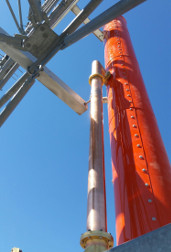ATSC 3.0 Components: Where They Are and What They Do
(Updated March 1 to reflect Feb. 23, 2017, standardization of A/432 Part: 2, AC-4 System.)
WASHINGTON—ATSC 3.0, the advanced broadcast transmission methodology, is referred to as “a standard,” but in reality is a suite of standards that will all come together as one in the first half of 2017 if all goes as intended.
The Advanced Television Systems Committee standardization process involves several steps leading up to final approval, including “candidate” and “proposed” standard phases. Currently, there are 19 individual standards in the pipeline, with possibly one or two more to come—one on a digital return channel, and perhaps another on part of the middle-layer specification.
Currently, nine of the 19 individual standards in the process pipeline are “Approved:”
A/321, “System Discovery and Signaling” (the bootstrap layer), approved March 23, 2016.
Provides a universal entry point into a broadcast waveform.
A/322, “Physical Layer Protocol,” approved Feb. 9, 2017.
Describes RF transmission of physical layer waveform in a way that supports flexible configurations for possible future uses.
A/330, “Link-Layer Protocol,” approved Sept. 19, 2016.
Provides a path to deliver IP packets, link layer signaling packets, and MPEG-2 transport stream packets down to the RF Layer and back, after reception.
A/333, “Service Usage Reporting,” approved Jan. 4, 2017.
Defines a standard for service usage reporting.
A/334, “Audio Watermark Emission,” approved Sept. 9, 2016.
Specifies the VP1 audio watermark.
A/335, “Video Watermark Emission,” approved Sept. 20, 2016.
Provides a path for an ancillary data payload that can survive changes in codecs, data rate and transcoding.
A/342 Part 1, “Audio Common Elements,” approved Jan. 24, 2017.
Defines a common framework for ATSC 3.0 audio.
A/342 Part 2: “AC-4 System,” elevated Dec. 26, 2016, approved Feb. 23, 2017.
Standardizes the AC-4 audio system.
A/343, “ATSC Standard: Captions and Subtitles,” Dec. 21, 2016.
Defines the required technology for closed caption and subtitle tracks over ROUTE-DASH and MMT transports, including the content essence and the packaging and timing.
Ten more components are working through the Candidate Standard (CS) phase, when ATSC members not involved in the CS working group are invited to weigh in. Once approved, they’ll become Proposed Standards:
A/324, “Scheduler/Studio to Transmitter Link,” elevated to CS Sept, 30, 2016, the CS period ends March 30, 2017.
Specifies the protocol on the SFN interface from studio-side infrastructure to SFN of transmitters.
A/331, “Signaling, Delivery, Synchronization, and Error Protection,” elevated Jan. 5, 2016, updated Sept. 21, 2016, CS period ends March 31, 2017.
Specifies the technology and procedures for service signaling and IP-based delivery over broadcast, broadband and hybrid networks.
A/332, “Service Announcement,” elevated Feb. 15, 2017, currently at ballot as a Proposed Standard.
Defines a standard for announcement of services in an ATSC 3.0 broadcast.
A/336, “Content Recovery in Redistribution Scenarios,” elevated Jan. 26, 2017, currently at ballot as a Proposed Standard.
Specifies methods for receivers to recover content available from a broadcaster, but not delivered directly to the receiver through the RF signal.
A/337, “Application Signaling,” elevated Jan. 19, 2017, CS period ends July 19, 2017.
Specifies mechanisms for signaling the properties of applications, and for delivering activation notifications synchronized with a time base.
A/338, “Companion Device,” elevated Jan. 20, 2017, currently at ballot as a Proposed Standard.
Specifies the communication protocol between an ATSC primary device and an ATSC companion device.
A/341, “Video—HEVC,” elevated Nov. 24, 2015; updated Jan. 17, 2017, currently at ballot as a Proposed Standard.
Describes the video coding constraints on ITU-T Rec. H.265|International Standard ISO/IEC 23008-2 HEVC.
A/342 Part 3: “MPEG-H System,” elevated Dec. 27, 2016, currently at ballot as a Proposed Standard.
Standardizes the MPEG-H Audio system.
A/344, “ATSC 3.0 Interactive Content,” elevated Dec. 29, 2016; the CS period ends June 29, 2017.
Defines the details of an environment required for broadcaster’s HTML5 applications to run.
A/360, “ATSC 3.0 Security and Service Protection,” elevated Oct. 28, 2016; the CS period ends March 31, 2017.
Specifies the mechanisms for security and service protections in ATSC 3.0 systems.
For more TV Technology coverage, see our ATSC 3.0 silo.

Get the TV Tech Newsletter
The professional video industry's #1 source for news, trends and product and tech information. Sign up below.
